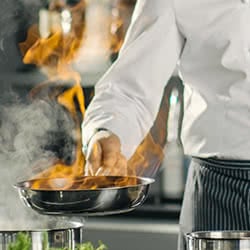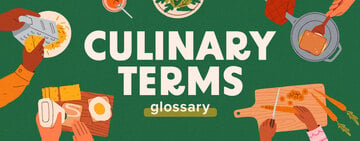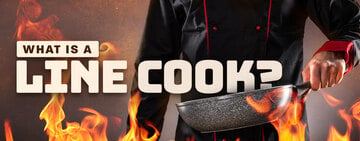
If you're training to become a chef in a commercial kitchen, you may hear some restaurant lingo that is completely new to you. Sometimes it seems like chefs and their kitchen staff have a language of their own. Time is crucial in a busy kitchen, which is why it's important to understand the unique shorthand that chefs use for quick communication between team members. We'll go over some of the most common slang terms used in commercial kitchens so you can anticipate the needs of your fellow chefs and work together seamlessly.
Understanding Chef Terms
Watch our video to learn why chefs say things like "all day" and "on the fly".
Glossary of Kitchen Slang Terms
To help you talk like a chef, we've made a glossary of common kitchen slang, the meaning of each phrase, and how to use the terms in a sentence.
A La Minute
The kitchen phrase a la minute is a French term that translates to at the minute or on the minute. It's used to describe a cooking method that relies on freshly prepared ingredients, but it's also used to signify a dish or condiment must be made to order.
Example: That sauce is made a la minute!
All Day
In chef slang, the expression all day is used to indicate the total number of orders needed. As tickets come in, a chef will shout out the orders followed by all day. If there are three orders of fries on one ticket and four orders of fries on another ticket, there are seven orders of fries all day.
Example: We have ten orders of artichoke dip and eight fries all day.

Behind
To avoid collisions with other staff members scurrying around a busy kitchen, it's considered polite to clearly say, "Behind," as you pass behind another person. This is even more important if you are carrying a full tray of food, a hot pan, or a rack of glassware. You might also hear variations of this expression like "Sharp behind," or "Hot behind," to indicate someone is passing by carrying an object that could harm another staff member.
Example: Don't step back, I'm behind.
Chit
When servers key in an order on the POS system, the corresponding ticket that prints out on the chef's line is called a chit.
Example: The shift just started and the rail is already filled with chits.
Covers
In kitchen slang, covers are the number of people, or heads, that are being served in the dining room. Restaurant managers count the number of covers that are served in one shift to determine what future shifts will be like. They can also make projections on how much customers will spend based on previous sales per cover.
Example: If we get the same covers as last Friday, it's going to be a busy night.
Dead Plate
A dead plate is a dish of food that is unservable, either because a customer sent it back or because it was prepared incorrectly. Dead plates are usually considered fair game for servers or cooks to eat, but it depends on the restaurant's policy.
Example: I hope that's a dead plate because I've seen two people grab fries off of it.
Dying on the Pass
A dish that is dying on the pass is sitting for too long in the window and is at the risk of becoming unservable.
Example: Can someone get this order out now? It's dying on the pass.
Deuce
In restaurant lingo, a dining room table that seats two people is nicknamed a deuce.
Example: So far, we only have a couple deuces on the floor. It might be a slow night.
Expo
Expo is the shortened term for expeditor, or the person in charge of organizing and traying up food before it's taken out to the dining room. An expo makes sure each dish is correct and then hands off orders to the food runner or server. This role is often rotated between servers, hosts, and managers. The area where the expo works is also sometimes called the expo window.
Example: We're definitely going to need an expo tonight. We're fully booked!
Fire
When servers key an order into the POS system and send it to the kitchen, they've just fired the order. Sometimes they will wait to fire the entrees until the appetizers have been served to help with the pacing of the meal. It's also considered bad etiquette to fire too many orders at once.
Example: I'm firing table five's apps right now!

Flash
If a dish needs to be reheated quickly, the cooks flash it with high heat on the charbroiler or in the salamander. This usually comes as a request from a server or expo when a dish is undercooked or has been sitting in the window too long.
Example: This plate looks cold! Can you flash it for me?
Floor
The dining room is referred to as the floor. When anyone from the kitchen walks out onto the floor, their uniforms should be clean and they should act appropriately in the sight of guests. Managers will do rounds and walk the floor several times during a shift to check on customers.
Example: Does everyone on the floor look happy?
Heard / Heard That
When the chef is calling out tickets, the cooking staff will indicate they got their orders by saying "Heard!" or "Heard that!"
Example: Two orders of broccoli? Heard that, chef!
In the Weeds / Weeded
The phrase in the weeds is kitchen lingo which means someone is really busy and having a hard time keeping up. It's a dreaded position to be in but happens to everyone, especially if the kitchen is understaffed on a busy night.
Example: I'm really in the weeds over here! Can someone help me?
Kill It
In restaurant jargon, kill it means to cook something extra well done. Killing a steak or a chicken breast means to overcook it.
Example: Make sure you kill this steak because they want it extra well.
Low Boy
An undercounter refrigerator is nicknamed a low boy. This could be any type of refrigeration unit that stands waist-high. Low boys are convenient for chefs because they keep chilled ingredients close at hand when they are on the line.
Example: Can you hand me some cheese slices from the low boy?
Mise
The word mise, pronounced meez, is a shortened version of the phrase mise en place. Mise en place translates to everything in its place. Cooks will use mise to indicate they have all the prep work for each dish completed.
Example: Everything is mised and I'm ready for dinner service.

On Deck
Using the phrase on deck is just like saying, "This order is coming up!" Cooks might call out new tickets and let the line know what is on deck. They'll also give servers a heads-up if their orders are on deck, or coming out soon.
Example: Don't leave the kitchen, your order is on deck!
On the Fly
When you need an order on the fly, you need it yesterday. If a server forgets to fire an order and suddenly realizes their table has been waiting 20 minutes, they will request an order on the fly.
Example: Table three needs an order of onion rings on the fly!
On the Line
The line refers to the area behind the kitchen window where chefs do most of the cooking during service. A typical line includes a walkway where the chefs stand, a grouping of cooking equipment behind them, and a workspace in front of them where they plate dishes.
Example: Who's working on the line tonight?
Pass
The pass is the area in front of the cooking line where orders are placed for servers to pick up. It can also be referred to as the window because many kitchens have an actual window between the line and the expo area.
Example: Your order's sitting on the pass.
The Rail / Board
Line cooks use the rail or board to hold all of their incoming tickets. It's a strip of metal above the food window that holds tickets in place so anyone on the line can clearly read the orders. Clearing the rail means that all the tickets have been completed.
Example: Let's clear this rail and get the orders out!
Run the Dish
Run the dish means to deliver a dish to a table. Many times, whoever is available in the kitchen when the order is on deck will be asked to run the dish.
Example: Can you run this dish to table eight?

Running the Pass
The cook in charge of calling out the tickets and making sure each order is complete is running the pass. It's important to have a point person on the line who can accurately call out orders to the other line cooks. The chef running the pass also works with the expo to make sure each dish is plated correctly.
Example: She always keeps her cool when she's running the pass.
SOS
In chef lingo, SOS is an acronym for sauce on the side. It can be used when keying in orders or as a spoken request.
Example: Can I get that order made SOS?
Stretch It
Stretch it is chef slang for making ingredients last as long as possible.
Example: Can you stretch that sauce for one more dish?
Waxing a Table
If a server is waxing a table, they are giving that table special treatment. This VIP service is usually reserved for important guests like the restaurant owner's family or regular customers who are known to be big tippers.
Example: There's a restaurant critic at table three so I need you to wax the table a little bit.
Two-Top / Three-Top
In restaurant slang, dining room tables are identified by how many guests they can accommodate. A table that seats two is called a two-top. A table that seats three is called a three-top.
Example: I have an open six-top in my section.
86
When a menu item has completely run out, chefs will say the dish is 86ed. Kitchen staff members need to communicate this to servers as soon as possible so that no more orders are placed for the item.
Example: Spread the word, the special is 86ed already.
New kitchen slang pops up all the time as chefs find new ways to communicate with each other. We've decoded some of the most common kitchen phrases used by cooks to help you integrate into restaurant culture. Understanding these terms will help you to be successful in whatever position you hold, whether you're a restaurant owner, chef, or server.





